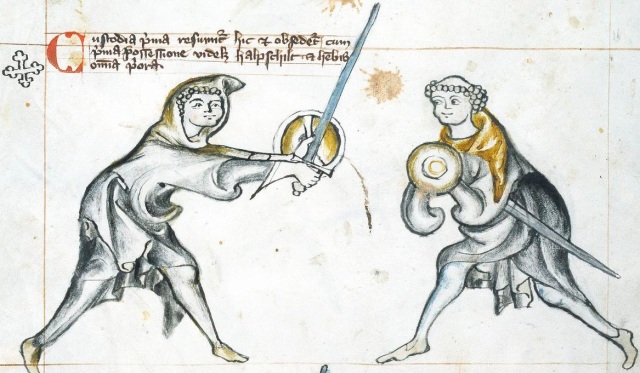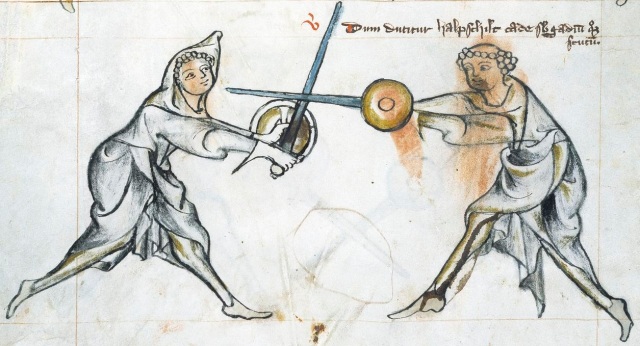This is an article that really should have been written a long time ago.
It’s a basic concept in I.33, and really illustrates the depth of the binding mechanics as well as the tactics used to enter a fight. I will discuss how Halfshield and Longpoint are both similar in their use as Sieges, they are crucially different in one specific way, and it’s an important distinction to be aware of when using Halfshield yourself to ensure it is effective.
Now, the text of I.33 doesn’t really give us a description of either Halfshield or Longpoint in physical terms, but we can observe some things about the illustrations. First, we will look at the depictions of Langort and Halpschilt and see what we can glean from them. We’re only given one illustration showing Langort used as an Obsessio, on Folio 16r:

Folio 16r, Langort besieging 1st Ward
We see that it is pretty clear what the position is. The sword is extended far forward, point directed right at the enemy, buckler crossed over top protecting the sword hand/arm. It is a very forward-leaning and low stance. It’s clear that this is an action ending with the swords tip in front of the opponent, not a direct thrust hitting the opponent.
Halfshield is depicted many times, and it varies a little bit in each illustration, but I’m only going to show one here from Folio 8v, since it’s from the same orientation as Langort shown above, and is besieging the same ward:

Folio 8v top, Halpschilt besieging 1st Ward
We see that the arms and hands are extended directly forward, with the sword hand slightly lower than the buckler hand, with the buckler on the left side facing left. The sword is the key part. We see that the guy doing Halfshield is a little bit closer to the guy in 1st Ward than when the Longpoint siege was done. But the key thing is the orientation of the sword. The sword is pointing upwards. Most people approximate it as being 45 degrees, but closer examination of all the illustration shows that most of the time the sword is more vertical than 45 degrees, and somewhere closer to 60 degrees from horizontal. In practice, many people will often do Halfshield and end with the point directed at the opponents face. Of course, this is usually by habit from doing longsword, where most actions with similar motions finish with the point on-line, and it’s almost a cardinal rule of longsword. But it’s clear that with halfshield, the point is clearly not intended to be directed at the opponents face. Once again, the stance is quite forward, similar to Langort.
Now that we’ve examined the illustrations, where do we go from here? Well, there’s a clear difference between the two. They both have a similar stance, and both have the arms extended the same way, but one has the sword pointing directly at the opponent, and the other has the sword pointed slightly forward, but upwards, and closer to vertical than to pointing at the enemy. But why? Halfshield is consistently shown as a good Obsessio to use, and is shown being used to besiege almost every Ward in the manual. Langort, when used as an Obsessio, is described as “common and of little worth”. We are then shown how the one being besieged (in 1st Ward, seen above in Folio 16r) can do three things: he can grab the tip of the opponents sword, which leads to a sequence of techniques involving grapples, disarms, hitting the hand with the buckler, etc. But the main responses seem to be that he can bind above on the right, or he can bind below on the left. In this sequence, we are only shown the first option, but the cases of binding above on the right or below on the left are dealt with in several other places in the manual. Of course, most important to note is the advice we are frequently given that while we may have the option to bind above or below against an opponents action, binding above (gaining the overbind) is always better. So we see that if someone besieges you with Langort, you can simply overbind them directly by striking onto their sword. This can be accomplished because their sword is extended forward, and you can easily strike with the middle or strong of your sword on the middle or weak of their sword, thus gaining the superior bind position.
Now, how does this relate to Halfshield? Well, whenever we see someone being besieged by Halfshield, their only response is to “Fall Under Sword and Shield“, which, according to Folio 23v, is an action where you “place [yourself] under the sword” of the opponent. I interpret this to be an underbind, and to the left. So, whereas if someone besieges you with Langort, you can respond by going directly to the right overbind (which is the superior and more useful bind), if they besiege you with Halfshield, you must go into the left underbind (which is better than dying, but still an inferior position to the overbind). This is due to the orientation of the sword in Halfshield. Halfshield denies the weak of your sword to your opponent. With your sword pointing up at 60 degrees, they cannot reach your weak with their strong, and if they were to try and bind the weak of your sword with their weak, it would be a very tenuous and fragile weak-to-weak bind. If you see them binding that way, you can just slip your tip out of the way and strike them in that tempo. Such an attempt at binding would not give them any measure of protection or control, and would not stop you from striking them. As such, they are then forced to bind with their weak or middle against your strong in an inferior position that puts you in an underbind, which is the outcome we see against Halfshield, whether the person is in 1st Ward, 3rd Ward, or Priest’s Specific Langort.

Folio 8v bottom, 1st Ward “Falls Under Sword and Shield” into a left underbind with the middle of his sword against the strong of the opponents (note that other depictions of Falling Under show slight variations on the bind, some where the guy Falling Under is binding closer to his weak, or closer to Halfshields strong.
So from this analysis we can see the advantage of Halfshield. More than that, we see the actual root purpose of Halfshield, and the reason why A) it is a better siege than Langort, and B) it is important to hold your sword oriented properly when doing Halfshield. So, remember to hold Halfshield with the sword pointing up! Do not point it at the opponent, since all you’re doing is giving up the weak of your sword to an easy overbind. If in doubt, hold your sword vertically in Halfshield (which is shown in one illustration). Too vertical is better than too horizontal, in this case. Remember that Besieging with Langort is “of little worth”, and don’t give your opponent the opportunity to retake the initiative and gain an overbind on you. Instead, enter with Halfshield, the sword pointing upwards, and force him into an inferior bind.
